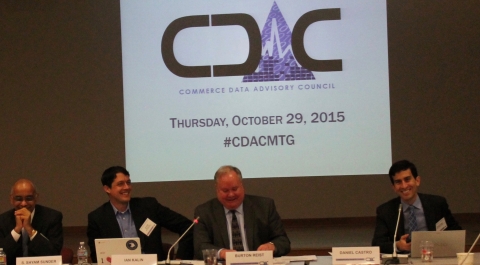Nov042015
Posted at 1:30 PM
Leaders from the nation’s technology and data industries came together on Oct. 29-30 for the third meeting of the Commerce Data Advisory Council (CDAC) in Boulder, Colorado. This meeting focused on three main themes: 1) organizing and disseminating troves of environmental data; 2) developing the expertise within government to maximize the value of all the data collected by federal agencies; and 3) ensuring our data and other cyber assets are protected from external threats.
Click here to watch video of the full sessions
The meeting was held at the National Oceanic and Atmospheric Administration’s (NOAA) David Skaggs Research Center, a hub of environmental data, both in the public and private sectors. Environmental data is the department’s largest set of data. Collecting, storing and disseminating this data present huge logistical challenges.
Tom Karl and Brian Eiler, senior leaders within NOAA, discussed how the agency is meeting this challenge, including through the NOAA Big Data Project. There is enormous untapped economic value in the data collected by NOAA. Through a partnership with private internet cloud services providers, we’re getting this data in the hands of more researchers and innovators. Together, we can unlock the potential of environmental data to solve some of our nation’s—and world’s—biggest challenges. These efforts have already yielded positive results. Just last week, Amazon Web Services announced the availability of NEXRAD radar data, which tracks precipitation and atmospheric movement, free to the public.
CDAC also addressed the development of a data skills infrastructure. Do we have the workforce, with the right skills, capable of unlocking the potential of this data? And can we better educate the public about the use of our data? Some agencies are developing powerful data tools, like Application Programming Interfaces (APIs), but too few agencies are moving in that direction. The CDAC has recommended developing strong internal educational resources—like Massive Open Online Courses (MOOCs)–and developing internal communities that can share new data insights and best practices.
Day 2 of the CDAC meeting addressed the challenges of cybersecurity and protecting Commerce data assets. The department’s data—particularly weather data—directly impact the lives and property of every American across the country. Ensuring that the data remains secure is a top priority for the department. The department’s Chief Information Officer Steve Cooper shared the steps he and his team are taking to review the security of Commerce data and the on-going process of encrypting this data.
The meeting closed with an inward look – what is our measure of success and how do we achieve it? This council has the ability to move the needle in terms of fully integrating data within the culture of the department. In the coming weeks and months, we will share any new developments stemming directly from the recommendations from the CDAC.



